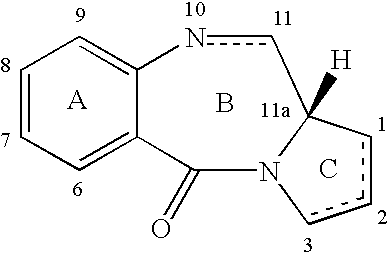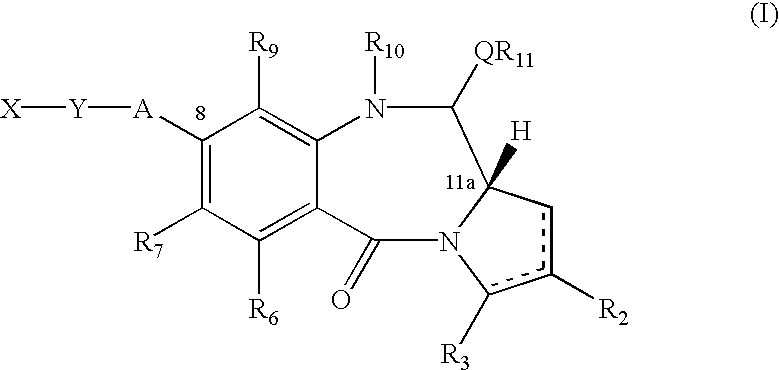Collections of compounds
a collection and compound technology, applied in combinational chemistry, chemical libraries, peptide preparation methods, etc., can solve the problems of higher yield of c, less cleavage of linking groups, and greater risk of undesirable side reactions with imine bonds during coupling steps
- Summary
- Abstract
- Description
- Claims
- Application Information
AI Technical Summary
Problems solved by technology
Method used
Image
Examples
example 1 (
Example 1(f)
Synthesis of Resin-bound Unprotected PBD (JGB-286)
##STR33##
A solution of piperidine in DMF (20%, 500 .mu.l) was added to the resin JGB-285 and the suspension shaken for 16 hours. The resin was filtered and rinsed with DMF (5 ml), CH.sub.2 Cl.sub.2 (5 ml) and MeOH (5 ml). This procedure was repeated twice and the resin was dried in vacuo to afford JGB-286.
example 2
Synthesis of 8-aminopropyl PBD of Formula I (See FIG. 2)
Overall Synthesis
The compound 19 was prepared by removal of Fmoc from 18 under standard conditions (piperidine / DMF). The Fmoc carbamate was obtained via Swern oxidation of the alcohol 17, which resulted in spontaneous closure of the pyrrolobenzodiazepine B-ring. A number of other oxidation methods should also prove effective in promoting the oxidation / cyclization reaction, for example, the Dess Martin reagent, the TPAP / NMO system or Pyridine Sulphur trioxide in DMSO. The alcohol 17 was furnished by treatment of the amino alcohol 16 with Nvoc-Cl in the presence of pyridine. As before this is a general procedure applicable to any chloroformate, the choice limited only by compatibility with the PBD and Fmoc cleavage conditions. The amine group can also be protected with numerous other carbamate protecting groups, the most useful in this instance being Alloc, Teoc and Noc due to their compatibility with Fmoc cleavage conditions. It...
example 3a
Synthesis of PBD-Triglycine 30 (FIGS. 3a & 3b)
This example was carried out to prove the general method of synthesis.
Resin Deprotection
Fmoc-aminoethyl photolinker NovaSyn TG resin 20 (0.35 g, 0.23 mmol / g loading) was placed in a peptide vessel, fitted with a sinter. After the addition of 20% piperidine in DMF (3 ml), the vessel was shaken for 3 hours. The deprotected resin 21 was then separated by filtration and rinsed with NMP (3 ml), MeOH (3 ml) and CH.sub.2 Cl.sub.2 (3 ml). The whole procedure was repeated twice before drying the resin in vacuo.
Coupling Conditions
DMF (2 ml) was added to resin 21 and the suspension shaken for 30 min. A solution of Fmoc-glycine (0.24 g, 0.805 mmol), TBTU (0.26 g, 0.805 mmol) and DIPEA (140 .mu.l, 0.805 mmol) in DMF (2 ml) was added and shaking continued for 20 hours. The coupled resin 22 was then filtered and rinsed with NMP (5 ml), MeOH (5 ml) and CH.sub.2 Cl.sub.2 (5 ml). The whole procedure was repeated once before drying the resin in vacuo. The ...
PUM
| Property | Measurement | Unit |
|---|---|---|
| temperature | aaaaa | aaaaa |
| temperature | aaaaa | aaaaa |
| temperature | aaaaa | aaaaa |
Abstract
Description
Claims
Application Information
 Login to View More
Login to View More - R&D
- Intellectual Property
- Life Sciences
- Materials
- Tech Scout
- Unparalleled Data Quality
- Higher Quality Content
- 60% Fewer Hallucinations
Browse by: Latest US Patents, China's latest patents, Technical Efficacy Thesaurus, Application Domain, Technology Topic, Popular Technical Reports.
© 2025 PatSnap. All rights reserved.Legal|Privacy policy|Modern Slavery Act Transparency Statement|Sitemap|About US| Contact US: help@patsnap.com



